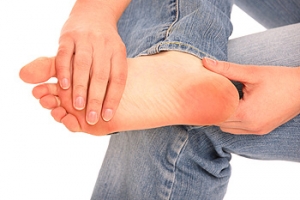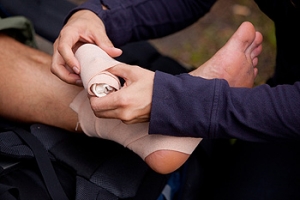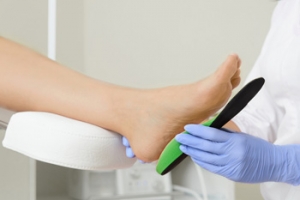
What Causes Pain in the Arch of the Foot?
 There are 26 bones, 30 joints, and almost 100 muscles and ligaments in the feet, and there are a variety of issues that may affect these components and lead to foot pain. Pain in different areas of the foot can be indicative of different conditions. Pain in the arch of the foot usually indicates common conditions such as plantar fasciitis, tarsal tunnel syndrome, or tibialis posterior tendonitis. Plantar fasciitis occurs when the plantar fascia, which runs along the bottom of the foot, becomes inflamed. Tarsal tunnel syndrome occurs when the tibial nerve gets squeezed or compressed where it goes through an opening in the ankle. Tibialis posterior tendonitis is an overuse injury that causes inflammation in the tibialis posterior tendon, which runs from inside the ankle to the bottom of the foot. Because of the variety of issues that lead to foot pain, patients who are struggling with foot pain should consult with a podiatrist for a proper diagnosis and treatment.
There are 26 bones, 30 joints, and almost 100 muscles and ligaments in the feet, and there are a variety of issues that may affect these components and lead to foot pain. Pain in different areas of the foot can be indicative of different conditions. Pain in the arch of the foot usually indicates common conditions such as plantar fasciitis, tarsal tunnel syndrome, or tibialis posterior tendonitis. Plantar fasciitis occurs when the plantar fascia, which runs along the bottom of the foot, becomes inflamed. Tarsal tunnel syndrome occurs when the tibial nerve gets squeezed or compressed where it goes through an opening in the ankle. Tibialis posterior tendonitis is an overuse injury that causes inflammation in the tibialis posterior tendon, which runs from inside the ankle to the bottom of the foot. Because of the variety of issues that lead to foot pain, patients who are struggling with foot pain should consult with a podiatrist for a proper diagnosis and treatment.
Foot Pain
Foot pain can be extremely painful and debilitating. If you have a foot pain, consult with Brian D. Jackson, DPM from Neuhaus Foot and Ankle. Our doctor will assess your condition and provide you with quality foot and ankle treatment.
Causes
Foot pain is a very broad condition that could be caused by one or more ailments. The most common include:
- Bunions
- Hammertoes
- Plantar Fasciitis
- Bone Spurs
- Corns
- Tarsal Tunnel Syndrome
- Ingrown Toenails
- Arthritis (such as Gout, Rheumatoid, and Osteoarthritis)
- Flat Feet
- Injury (from stress fractures, broken toe, foot, ankle, Achilles tendon ruptures, and sprains)
- And more
Diagnosis
To figure out the cause of foot pain, podiatrists utilize several different methods. This can range from simple visual inspections and sensation tests to X-rays and MRI scans. Prior medical history, family medical history, and any recent physical traumatic events will all be taken into consideration for a proper diagnosis.
Treatment
Treatment depends upon the cause of the foot pain. Whether it is resting, staying off the foot, or having surgery; podiatrists have a number of treatment options available for foot pain.
If you have any questions, please feel free to contact one of our offices located in Columbia and Pulaski, TN . We offer the newest diagnostic and treatment technologies for all your foot care needs.
Foot Pain
Our feet are arguably the most important parts of our bodies because they are responsible for getting us from place to place. However, we often don’t think about our feet until they begin to hurt. If you have pain in your feet, you need to first determine where on the foot you are experiencing it to get to the root of the problem. The most common areas to feel pain on the foot are the heel and the ankle.
Heel pain is most commonly attributed to a condition called plantar fasciitis. Plantar fasciitis occurs when the plantar fascia, which is the band of tough tissue connecting the heel bone to the toes becomes inflamed. Plantar fasciitis pain is usually worse in the morning, and it tends to go away throughout the day. If you have plantar fasciitis, you should rest your foot and do heel and foot muscles stretches. Wearing shoes with proper arch support and a cushioned sole has also been proven to be beneficial.
Some common symptoms of foot pain are redness, swelling, and stiffness. Foot pain can be dull or sharp depending on its underlying cause. Toe pain can also occur, and it is usually caused by gout, bunions, hammertoes, ingrown toenails, sprains, fractures, and corns.
If you have severe pain in your feet, you should immediately seek assistance from your podiatrist for treatment. Depending on the cause of your pain, your podiatrist may give you a variety of treatment options.
Why Is Excessive Sweating Bad for the Feet?
If your feet sweat excessively, you may have plantar hyperhidrosis. This condition is thought to be caused by overactivity in the part of the brain responsible for regulating body temperature and sweating, and it often runs in families. Besides being embarrassing and potentially ruining your socks and shoes, plantar hyperhidrosis can also cause an unpleasant foot odor, blistering dermatitis, and secondary infections of the skin on the feet. If you suspect that you may have plantar hyperhidrosis, don’t hesitate to schedule an appointment with a podiatrist near you. There are a variety of effective treatment options for this condition, including topical antiperspirants, iontophoresis, oral medications, Botox injections, and more.
If you are suffering from hyperhidrosis contact Brian D. Jackson, DPM of Neuhaus Foot and Ankle. Our doctor can provide the care you need to attend to all of your foot and ankle needs.
Hyperhidrosis of the Feet
Hyperhidrosis is a rare disorder that can cause people to have excessive sweating of their feet. This can usually occur all on its own without rigorous activity involved. People who suffer from hyperhidrosis may also experience sweaty palms.
Although it is said that sweating is a healthy process meant to cool down the body temperature and to maintain a proper internal temperature, hyperhidrosis may prove to be a huge hindrance on a person’s everyday life.
Plantar hyperhidrosis is considered to be the main form of hyperhidrosis. Secondary hyperhidrosis can refer to sweating that occurs in areas other than the feet or hands and armpits. Often this may be a sign of it being related to another medical condition such as menopause, hyperthyroidism and even Parkinson’s disease.
In order to alleviate this condition, it is important to see your doctor so that they may prescribe the necessary medications so that you can begin to live a normal life again. If this is left untreated, it is said that it will persist throughout an individual’s life.
A last resort approach would be surgery, but it is best to speak with your doctor to find out what may be the best treatment for you.
If you have any questions please feel free to contact one of our offices located in Columbia and Pulaski, TN . We offer the newest diagnostic and treatment technologies for all your foot and ankle needs.
Hyperhidrosis of the Feet
Hyperhidrosis of the feet, also termed plantar hyperhidrosis, is characterized by excessive sweating of the feet that can be onset by any cause, such as exercise, fever, or anxiety. Most people suffering from hyperhidrosis of the feet also experience hyperhidrosis of the hands, or palmar hyperhidrosis. Approximately 1-2% of Americans suffer from this disorder.
Sweating is a healthy process utilized by the body in order to cool itself and maintain a proper internal temperature, which is controlled by the sympathetic nervous system. In individuals with hyperhidrosis, the sympathetic nervous system works in "overdrive", producing far more sweat than is actually needed.
Plantar hyperhidrosis is considered primary hyperhidrosis. Secondary hyperhidrosis refers to excessive sweating that occurs in an area other than the feet, hands, or armpits, and this indicates that is related to another medical condition, such as menopause, hyperthyroidism, or Parkinson's disease.
Symptoms of hyperhidrosis of the feet can include foot odor, athlete's foot, infections, and blisters. Because of the continual moisture, shoes and socks can rot which creates an additional foul odor and can ruin the material, requiring shoes and socks to be replaced frequently. In addition to the physical symptoms, emotional health is often affected as this disorder can be very embarrassing.
If left untreated, hyperhidrosis will usually persist throughout an individual's life. However, there are several treatment options available. A common first approach to treating hyperhidrosis of the feet is a topical ointment. Aluminum chloride, an ingredient found in antiperspirants, can be effective at treating hyperhidrosis if used in high concentration and applied to the foot daily. Some individuals can experience relief this way, while others encounter extreme irritation and are unable to use the product. Another procedure is the use of Botulinum Toxin A, commonly referred to as Botox. This is injected directly into the foot, and is effective at minimizing the sweat glands in the injected area. These injections must be repeated every 4 to 9 months.
If these treatments are ineffective, oral prescription medications may be taken in an effort to alleviate the symptoms. Again, some will experience relief while others do not. Going barefoot reportedly provides relief for most sufferers.
A final approach to combating hyperhidrosis of the feet is through surgery. Surgery has been less successful on patients with plantar hyperhidrosis than on those with palmar hyperhidrosis. It is only recommended when sweating is severe and other treatments have failed to work. This kind of surgery usually involves going into the central nervous system, and cutting nerves to stop the transmission of signals telling the foot to sweat.
What Happens During an Ankle Sprain?
 A common symptom of an ankle sprain is redness and swelling after it has been twisted. It can happen as a result of stepping off of a curb unexpectedly, and this may cause the ligaments on the outside of the ankle to stretch and tear. When an ankle sprain is mild, the ankle may feel stiff, and it can be relatively stable to walk on. Bruising and tenderness may be apparent if the sprain is severe, and walking can be difficult. It is important to rest and elevate the affected foot immediately after the incident has occurred, and this may help to relieve a portion of the swelling. Some patients find it useful to wear an elastic compression wrap, and this can be beneficial in providing adequate stability as the healing process occurs. If you have sprained your ankle, please consult with a podiatrist who can properly diagnose and effectively this condition.
A common symptom of an ankle sprain is redness and swelling after it has been twisted. It can happen as a result of stepping off of a curb unexpectedly, and this may cause the ligaments on the outside of the ankle to stretch and tear. When an ankle sprain is mild, the ankle may feel stiff, and it can be relatively stable to walk on. Bruising and tenderness may be apparent if the sprain is severe, and walking can be difficult. It is important to rest and elevate the affected foot immediately after the incident has occurred, and this may help to relieve a portion of the swelling. Some patients find it useful to wear an elastic compression wrap, and this can be beneficial in providing adequate stability as the healing process occurs. If you have sprained your ankle, please consult with a podiatrist who can properly diagnose and effectively this condition.
Although ankle sprains are common, they aren’t always minor injuries. If you need your ankle injury looked at, contact Brian D. Jackson, DPM from Neuhaus Foot and Ankle. Our doctor can provide the care you need to keep you pain-free and on your feet.
How Does an Ankle Sprain Occur?
Ankle sprains are the result of a tear in the ligaments within the ankle. These injuries may happen when you make a rapid shifting movement while your foot is planted. A less common way to sprain your ankle is when your ankle rolls inward while your foot turns outward.
What Are the Symptoms?
- Pain at the sight of the tear
- Bruising/Swelling
- Ankle area is tender to touch
- In severe cases, may hear/feel something tear
- Skin discoloration
Preventing a Sprain
- Wearing appropriate shoes for the occasion
- Stretching before exercises and sports
- Knowing your limits
Treatment of a Sprain
In many cases, the RICE method (Rest, Ice, Compression, and Elevate) is used to treat ankle sprains. However, you should see a podiatrist to see which treatment option would work best with your injury. In severe cases, surgery may be required.
It is important to ask your doctor about rehab options after you receive treatment for your injury. Stretching, strength training, and balance exercises may help the ankle heal while also preventing further injury.
If you have any questions, please feel free to contact one of our offices located in Columbia and Pulaski, TN . We offer the newest diagnostic and treatment technologies for all your foot care needs.
Ankle Sprains
Although ankle sprains may not be as serious as a broken ankle, they should be given immediate attention and care. An ankle sprain can lead to a significant amount of pain, as well as limited mobility. They are often characterized by the swelling and discoloration of the skin. This occurs when the ligaments are stretched beyond their limits.
The simple act of walking can sometimes cause a sprain, which makes ankle sprains a very common injury that can happen to anyone. They occur when the ankle twists in an awkward way or rolls over itself, causing a pop or snap in the tendons around the ankle. Some people are more at risk than others. These include athletes who continually push their bodies to the limits and also people who have previously suffered accidents to the feet, ankles, or lower legs.
Most of the time, an ankle sprain is not severe enough for hospital attention. There are many at-home treatment options available, including propping the leg up above your head to reduce blood flow and inflammation, applying ice packs to the affected area as needed, taking over-the-counter pain relievers and anti-inflammatory medication, using an ACE bandage to wrap and support the injured ankle, and most importantly, remaining off your feet until the ankle has fully healed.
Despite this, an ankle sprain can turn into a severe injury that might require hospitalization. If the ankle ligaments or muscles are damaged from a tear or rip, that is one sign that the sprain is severe enough for hospital attention and possibly for surgery. Even after the surgery, the recovery process can be long. You may need to have rehabilitation sessions administered by your podiatrist to get your ankle back to full health.
The severity of your sprain might become apparent if you are unable to stand or walk, consistent pain occurs over a prolonged period of time, swelling is much more severe than initially present, or if you start to experience tingling or numbness. These signs may indicate that your ankle sprain might actually be a broken ankle, an injury that requires immediate medical attention.
Although they are not completely avoidable, ankle sprains can be curbed with some preventative treatment measures. These include wearing appropriate-fitting shoes that not only provide a comfortable fit, but also ankle support. It is also recommended to stretch before doing any kind of physical activity, as this will help lower your body’s chance for an injury.
How Custom Orthotics Can Help Treat Flatfoot
As the main stabilizing structure supporting the arch, the posterior tibial tendon is an important and hard-working tendon. Though with repetition or overuse, this tendon can become injured. This injury can contribute to pain and stress on the arch which can change the gait and even cause the arch to collapse over time. Prescription orthotics that are custom fit to the individual’s feet may be one form of treatment a podiatrist might use to help support and stabilize the arch and correct gait abnormalities. If you have pain on the inside of your foot or ankle, an appointment with a podiatrist is suggested for an accurate diagnosis and evaluation of your condition.
Flatfoot is a condition many people suffer from. If you have flat feet, contact Brian D. Jackson, DPM from Neuhaus Foot and Ankle. Our doctor will treat your foot and ankle needs.
What Are Flat Feet?
Flatfoot is a condition in which the arch of the foot is depressed and the sole of the foot is almost completely in contact with the ground. About 20-30% of the population generally has flat feet because their arches never formed during growth.
Conditions & Problems:
Having flat feet makes it difficult to run or walk because of the stress placed on the ankles.
Alignment – The general alignment of your legs can be disrupted, because the ankles move inward which can cause major discomfort.
Knees – If you have complications with your knees, flat feet can be a contributor to arthritis in that area.
Symptoms
- Pain around the heel or arch area
- Trouble standing on the tip toe
- Swelling around the inside of the ankle
- Flat look to one or both feet
- Having your shoes feel uneven when worn
Treatment
If you are experiencing pain and stress on the foot you may weaken the posterior tibial tendon, which runs around the inside of the ankle.
If you have any questions please feel free to contact one of our offices located in Columbia and Pulaski, TN . We offer the newest diagnostic and treatment technologies for all your foot and ankle needs.
Flat Feet
Flatfoot is a condition that occurs when the arches on the foot are flattened, which allows the soles of the feet to touch the floor. Flatfoot is a common condition and it is usually painless.
Throughout childhood, most people begin to develop arches in their feet, however, some do not. Those who do not develop arches are left with flatfoot. The pain associated with flat feet is usually at its worse when engaging in activity. Another symptom that may occur with those who have this condition is swelling along the inside of the ankle.
It is also possible to have flexible flatfoot. Flexible flatfoot occurs when the arch is visible while sitting or standing on the tiptoes, but it disappears when standing. People who have flexible flatfoot are often children and most outgrow it without any problems.
There are some risk factors that may make you more likely to develop flatfoot. Those who have diabetes and rheumatoid arthritis have an increased risk of flatfoot development. Other factors include aging and obesity.
Diagnosis for flat feet is usually done by a series of tests by your podiatrist. Your podiatrist will typically try an x-ray, CT scan, ultrasound, or MRI on the feet. Treatment is usually not necessary for flat foot unless it causes pain. However, therapy is often used for those who experience pain in their flat feet. Some other suggested treatment options are arch supports, stretching exercises, and supportive shoes.
The Duties of a Podiatrist
 A podiatrist is a medical professional that specializes in the care of the feet and ankles. A podiatrist’s duties typically include examining patients, diagnosing various foot and ankle conditions, and providing the appropriate treatments for a variety of foot and ankle needs. Some podiatrists specialize in podiatric surgery and perform operations such as joint replacement surgeries and bunionectomies. Podiatrists are also often the first to notice signs of diabetes, neuropathy, peripheral artery disease, rheumatoid arthritis, and other systemic conditions that can affect the feet. In those cases, a podiatrist may not only treat your disease-related foot and ankle problems, but also refer you to a specialist for the suspected systemic disease. If you are experiencing any foot or ankle pain, don’t hesitate to schedule an appointment with a podiatrist near you.
A podiatrist is a medical professional that specializes in the care of the feet and ankles. A podiatrist’s duties typically include examining patients, diagnosing various foot and ankle conditions, and providing the appropriate treatments for a variety of foot and ankle needs. Some podiatrists specialize in podiatric surgery and perform operations such as joint replacement surgeries and bunionectomies. Podiatrists are also often the first to notice signs of diabetes, neuropathy, peripheral artery disease, rheumatoid arthritis, and other systemic conditions that can affect the feet. In those cases, a podiatrist may not only treat your disease-related foot and ankle problems, but also refer you to a specialist for the suspected systemic disease. If you are experiencing any foot or ankle pain, don’t hesitate to schedule an appointment with a podiatrist near you.
If you are experiencing pain in the feet or ankles, don’t join the stubborn majority refusing treatment. Feel free to contact Brian D. Jackson, DPM from Neuhaus Foot and Ankle. Our doctor can provide the care you need to keep you pain-free and on your feet.
What Is a Podiatrist?
Someone would seek the care of a podiatrist if they have suffered a foot injury or have common foot ailments such as heal spurs, bunions, arch problems, deformities, ingrown toenails, corns, foot and ankle problems, etc.
Podiatric Treatment
A podiatrist will treat the problematic areas of the feet, ankle or lower leg by prescribing the following:
- Physical therapy
- Drugs
- Orthotic inserts or soles
- Surgery on lower extremity fractures
A common podiatric procedure a podiatrist will use is a scanner or force plate which will allow the podiatrist to know the designs of orthotics. Patients are then told to follow a series of tasks to complete the treatment. The computer will scan the foot a see which areas show weight distribution and pressure points. The podiatrist will read the analysis and then determine which treatment plans are available.
If you have any questions please feel free to contact one of our offices located in Columbia and Pulaski, TN . We offer the newest diagnostic and treatment technologies for all your foot and ankle needs.
















